#Finnish fashion
Explore tagged Tumblr posts
Photo

Aino, 24
“I’m wearing a mini dress paired with pants and oversized blazer, all second hand. Platform sandals are from Vagabond and bag from Balenciaga. I built the look around the black lace gloves I got from a friend. The bows in my hair and on my pants are my favourite detail of the outfit.”
26 May 2023, Otaniemi
654 notes
·
View notes
Text

Model wearing Vuokko overalls photographed by Kari Rainer Pulkkinen, late 1960.
(source: Museovirasto/Finnish Heritage Agency via Europeana Collections)
#vintage fashion#1960s fashion#vuokko#finnish fashion#fashion photography#kari rainer pulkkinen#vintage jumpsuit
20 notes
·
View notes
Text

Springtime (Portrait of Anna Slöör), Akseli Gallen-Kallela. n.d.
#art#aesthetic#art history#historical fashion#fashion#historical art#women in art#women#victorian#victorian aesthetic#edwardian aesthetic#spring#springtime#finland#finnish#finnish art#finnish artist#flowers aesthetic#flower aesthetic#Edwardian fashion#Victorian fashion#cottagecore art#cottagecore aesthetic#cottagecore
60 notes
·
View notes
Text
Sometimes I wonder what Tolkien would think about the fact that his books have been popular for so long that some of the words in it have started to change meaning
#this actually isn't even because of all the queers and the gays in the text (although i certainly giggle at those way more than i should)#this time i'm thinking abt this because of that bit in gandalf's letter to frodo. where he says something about how if butterbur#doesn't send the letter forward in a timely fashion gandalf 'shall roast him'#and just. i'm intelligent enough to figure out the general gist of what that's supposed to mean from the context (plus i've read the book#in finnish more times than i've read it in english and the finnish word choice hasn't changed meaning in the same way in the last 50 years)#but also despite that i just. can't help the mental image of the 'roasting' in the figurative sense of the word that i'm more familiar with#lotr#lord of the rings#middle earth#tolkien
100 notes
·
View notes
Note
Hey, I noticed that in one of your posts you showed an Iron Age Finnish woman's dress. Would you happen to have a good idea of what Finnish men were wearing in that era? The information on it seems sparse. I do have a relevant book that I'm about to look through, but I'd like to hear your insight too!
Hi! Thanks for the question (and sorry for the slow answer), I do love Finnish Iron Age clothing so it's always my pleasure to write about it. I've been wanting to do a deep dive into this for a long while, so maybe I'll do at some point a post about women's dress too.
Unfortunately no one has good idea of the Finnish Iron Age men's dress (and if you find any book or other source that claims otherwise, do not trust it), since there's much fewer archaeological finds of men's dress than women's dress. The most accepted theory on why the textiles of women's dress survived surprisingly well is because of the bronze ornamentation commonly sewn into especially the fine women's dresses of the era. The bronze protected them from decomposing fully. Presumably men's dresses were not decorated similarly then. There are some finds though and we can piece together at least some kind of vague picture.
I will be discussing the period from Viking Age to Crusade Age in Finland. Viking Age is often defined to cover 800s to mid-1000s and the Finnish Crusade Age started right after the Viking Age and ended in the end of 1200s, where the Finnish Medieval era begins. Crusade Age refers to the period where mostly Swedish (also German) crusaders in the span of couple of centuries conquered lands of the Baltic-Finnic pagans. The crusades of this period targeted pagans all over eastern Baltic Sea, including Baltic-Finnic Karelians, Livonians and Estonians, and Baltic peoples, and the Scandinavia too, where Sámi people were targeted. After that the Finland and Sápmi were colonized by Norse people and stayed that way untill Finland was transferred under Russian rule, but to this day Sápmi still stays under colonial rule, including Finnish colonial rule. The current Finland was very multicultural area, mostly populated by Finno-Ugric peoples, including Sámi people, Karelians and various Finnish peoples.
It's important to understand that even just Finnish peoples where not homogeneous, but had distinct, yet of course strongly related cultures. These were Finns (suomalaiset) (yes most people we now call Finns were not in fact called that) in the coast of southwestern and western Finland, Tavastians (hämäläiset) in central-western lake-Finland and Savonians (savolaiset) in central-eastern lake-Finland. This means we can't mix findings from all over Finland to reconstruct a dress without evidencing that all the elements were actually used in one place. These three tribes had broadly similar base for their clothes, but distinctive jewelry and detailing. The big divide was and has always been between eastern and western Finnish peoples. This is because western Finnish people were in close contact through the sea with Norse people and southern Baltic-Finnic peoples, while eastern Finnish people, Savonians mostly, were influenced a lot by their proximity with Karelians. Another dividing factor was the very different environmental conditions between western and eastern Finland. The Finnish coast especially in west is very flat and fertile land, while the lake area, especially in eastern Finland is very rocky, hilly and quite infertile. The main way it effected clothing differences was that western Finland being more wealthy had more elaborate clothing. Tavastians in both occasions fall quite in between, but they tended to be more in the western cultural camp.
My most important sources are a study by a doctor of cultural anthropology, Jenny Kangasvuo, Savon historia I (Savonian history) digitized and open sourced here and the digitized archeological collection of Finnish Heratage Agency. They are all in Finnish so not very useful for most people unfortunately.
Finnish Men's Dress in Viking and Crusader Ages
The basic garments men wore were broadly similar as women. They wore a shift/shirt, knee or above-knee length dress, cloak, belt, shoes and some kind of headwear. Wool was used most commonly, though the shirt would sometimes be linen too. Even evidence of silk has been found in some western Finland graves. I would assume that would be from a dress of some great man, who traveled to gain riches, possibly with vikings. Embroidery and decoration with metals was a typical feature of the whole Eastern Baltic Sea area. In Finland during this period bronze was the most common decorative metal, but silver was used too. Decorative elements were usually woven with small bronze spirals into all kinds of patterns. Here's examples from the reconstructed Ravattula's dress (Finns) used by women.
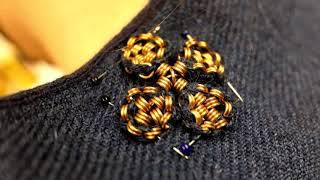
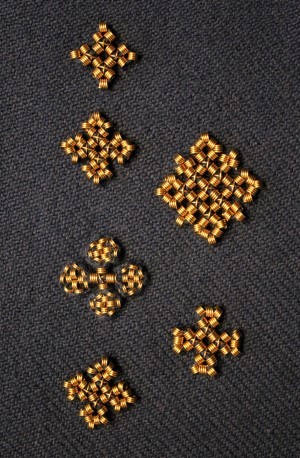
Shirt
The shirt (in Finnish shift of both women and men was called shirt) was basically a long shirt or under dress. We can assume it was similar to those of women's except shorter since the dress men wore was shorter too. They were made from wool or linen, I would assume wool was used in winter and linen in summer, when linen was even available. The neckline had a cut and closed with a bronze brooch. Horseshoe brooch was common. The first one is a quite typical bronze horseshoe brooch with a bit of ornamentation from Salo (Finns). The second one is from Tuukkala, (Savonians), it has exceptional ornate detailing and is uncommonly silver, not bronze. The third picture has two quite uniquely ornamented horseshoe brooches, first from Köyliö (Finns), second from Kurikka (Finns).
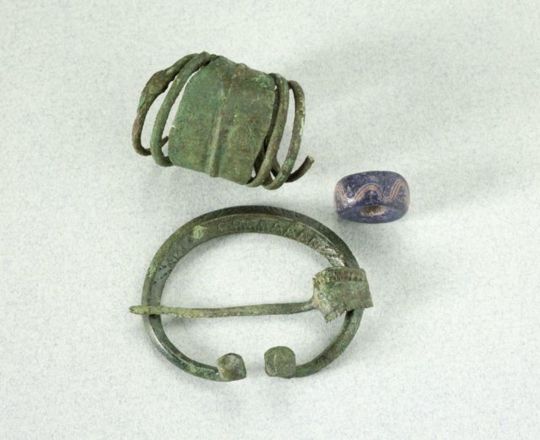


Legwear and footwear
Very little of men's legwear has survived and it's unclear weather men wore pants or separate pant legs, leg wraps or perhaps long socks. Evidence of strings decorated with bronze spirals and tablet woven band has been found in leg area of men's graves. This could mean that they wore either leg wraps, long sock or some sort of pant legs that needed to be secured with string or band under knee. Women used strings and tablet woven tape to secure leg wraps and socks, which I think supports that theory. Sometimes both bronze decorated string and tablet woven band was found in the leg area, which would still be explained by this theory, since it was common to decorate the ends of the bands with bronze decorated strings. Here's an example of sock bands just like that from the earlier mentioned reconstruction of the Ravattula's women's dress. Since men's dress was shorter, I think it would make sense if they still wore some kind of pants or separate pant legs with socks or leg wraps like that.

However, the strings and bands could have also been part of the shoes. Everyone probably wore similar shoes - laced leather shoes with a bit of pointed end. They might have been short or ankle length and the lacing was done with either leather cord or tablet woven band, which would also explain the findings. Socks or feet wraps would have been used in them, and straw or wool could be added as filling for warmth. Here's a pair of traditional Izhorian shoes from Estonia from early 1900s, and a pair of traditional Sámi shoes. The designs were likely roughly similar in Viking and Crusader Ages, though obviously more simple, and it's probable that Finnish shoes very something like that too. Here's a 1893 drawing of what findings of shoe material from Korpiselkä (Savonian or Karelian) might have looked like. Considering the quality of archaeology of that time, copious amounts of salt should be applied. And finally as a fourth picture there's reconstruction shoes from Ravattula's dress.
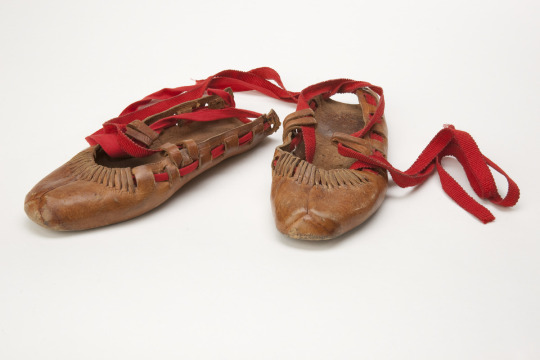
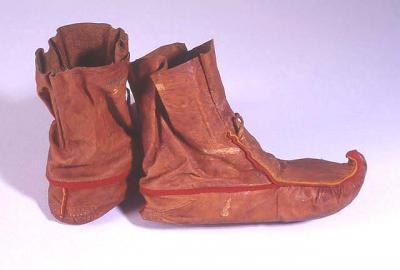
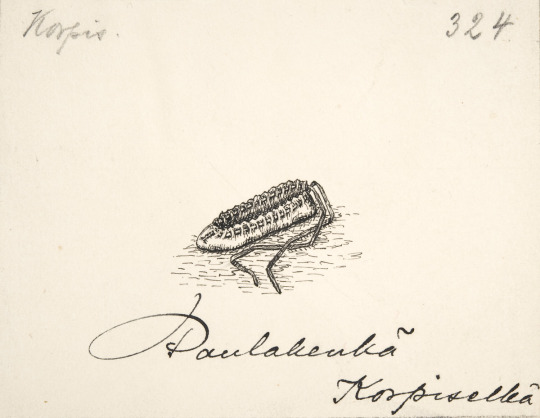
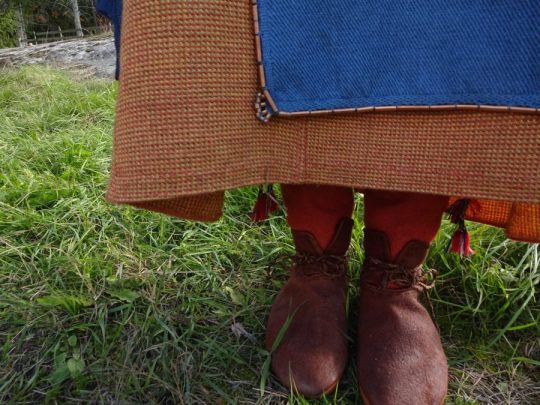
These are not necessarily mutually exclusive theories. The lacing of the shoe could have been laced up the leg and used also to secure either sock or leg wrapping, or they could have been separately secured in ankle and knee respectively.
In some graves twill fabric has been found in the leg area. It could be part of pants or for example leg wrapping, which was often made of twill. One theory about pants is that they were similar as some findings in Sweden, where fairly tight pants made of twill were secured at the hem with buttons similar to cuff studs. These kinds of cuff stud buttons are quite a common find in Finland and some have been found in men's graves close to legs.
Dress
Again there's not much findings of dresses, but a little more perhaps. It was usually from wool. The shape was either a tunic or an open coat. In Karelia there's findings of men's dress suggesting tunics thicker than women's dresses and made from sarka, a type of broadcloth. On the other hand, in Masku (Finns) they found buttons in a row on top of the torso, which suggest a coat closed with buttons. The first picture is a drawing of the grave find. Similary coak closing amounts of buttons have also been found in other places in western Finland. This suggests that Finns and probably Tavastians too wore long coats buttoned to the waist and Savonians wore tunic of Karelian influence. Below there's couple of version of what might this western Finnish men's coat dress could've looked like. The first is an imagined version of the coat based on the Masku grave finds, second is just as imagined version based on Eura (also Finns) grave finds.
Take these "reconstructions" with a strong dose of salt. These are more artistic reconstructions than scientific, since there's not enough material and too much guesswork needs to be done. And because we can see in the Masku grave drawing right here that the other deceased has a large buckle to (probably) close the shirt (to be fair, it could for a cloak too), like was typical, I find it implausible that the coat neckline would be small and round covering the buckle. If you make a decorated big buckle, I assume you want to show it. I would find a v-neckline more probable. It's also easier to make without wasting expensive fabric.


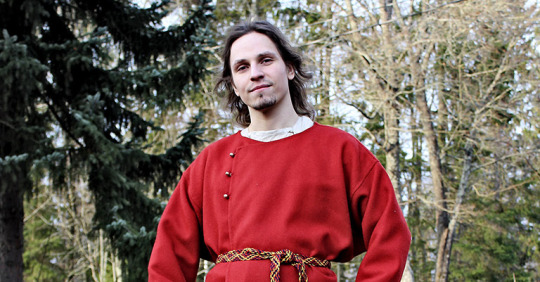
The buttons are interesting. There were what you would imagine - your typical buttons made of bronze like seen in the first artifact from Hattula (Tavastians). But then there was silver jingle bells used as buttons, found for example in both Masku and Eura graves, Eura findings pictured below.

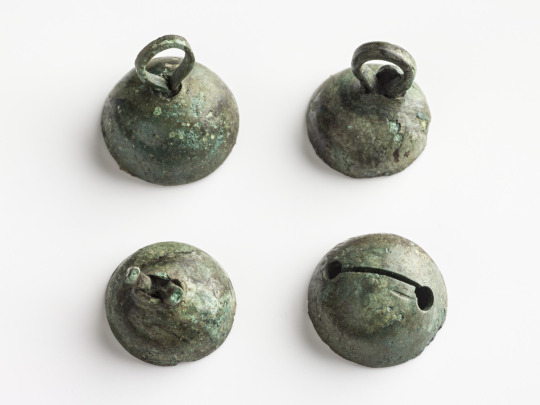
It's possible, even probable I'd say, that the hemlines of men's dresses were finished with tablet weaving patterns, like women's dresses. Also I would assume the pattern of the men's dress (and shirt) was mostly similar to the women's underdress/shirt patterns. So here's couple of different reconstruction patterns for women's dress. Different historians have made different interpretations of the patterns, so it's very much undecided what it really was like.


Belt
This is likely the most ornamental part of men's dress. They could be made out of leather or tablet woven band. And there's another east-west cultural divide here. Karelian belts were made out of leather, were usually 1,5-2,5 cm wide, decorated with iron or bronze studs and had a buckle made out of iron or bronze. These types of belts have been found in Savonia too, for example in Tuukkala grave find, which you can find very cool pictures of in this photo documentation of the dig in pages 173-175. In western Finland a "hela" belt was the common style. I don't think there's a world for hela in English. It's a sort of decorative lamella, small metallic plate (not necessarily square but often so) attached to fabric or leather with studs or sewing. Hela belt came from the Permians of Kama river, who were one of the many Finno-Ugric peoples who used to populate much of European side of Russia. Karelians lived closer to Permians, so you might think Permians would influence eastern Finland more, but my theory is that the costal Finns, who frequently joined viking crews and at least were in close contact with merchants including vikings, who would travel along the eastern route through the eastern European rivers, where they could go all the way to Kama river or at least meet traveling Permians. Here's yet another Finnish source more on the Finno-Ugric people around Kama river.
Anyway, hela belt was made of leather and filled with small decorated lamellas, often in square shape, but various other shapes too, like animal ornamentation. In this period hela belt helas were bronze. First image is a nice full set of hela belt metal pieces found in Pirkanmaa (Finns). Second is an older example, right before Viking Era, from Vaasa, costal settlement, (Finns), depicting a very Permian style. The third one is a lion hela found separately in Pälkäne (Tavastians). They are also found in Tuukkala, showing that both eastern and western cultural influences were present there at the same time.
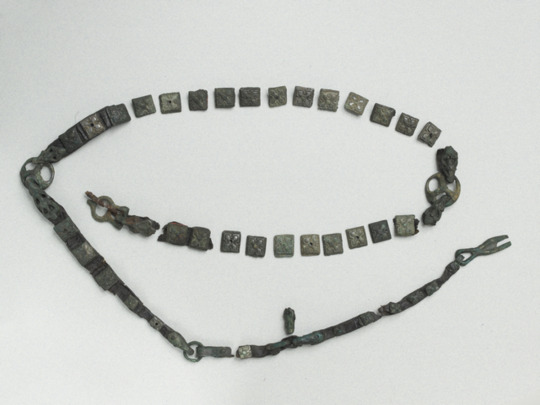
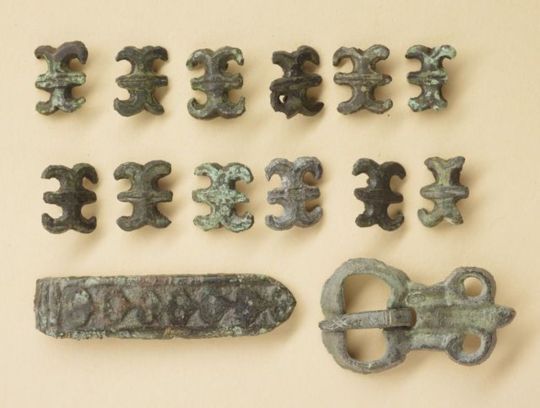

Another western Finnish belt type for men had intricate tassels decorated with bronze spirals hanging on the waist at the end of the belt. They could be made out of leather or tablet woven band. First image depicts a reconstruction of such tassel. Belts in east and west would have strap dividers to hang straps for things like purse, knife and sword. The first picture above has couple of those, but the second picture below has two more of them in more detail in the middle of the picture. These finds are from Lieto (Finns).
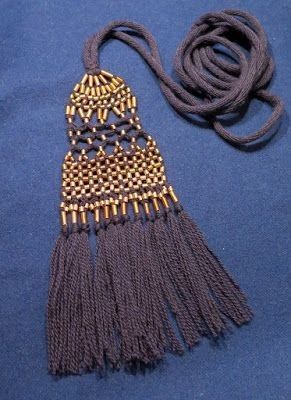
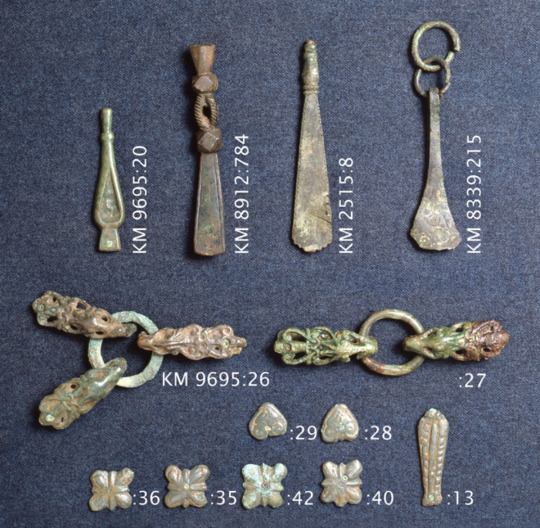
Cloak
Like women's cloak, men's cloak was woolen and either a square or trapezoid. Cloak is yet another east-west divide. In western Finland men's cloaks have embroidery with bronze spirals. They in fact appeared earlier in men's cloaks (in 900s) than in women's cloaks (1100s). They were also a little different in men's cloaks. The spirals and the patterns themselves were bigger and the fastening thread itself was also used for the pattern creation, unlike in women's dresses, where the thread was mostly covered. In eastern Finland there has been no finds of bronze decorations in men's cloaks, mostly only cloak brooches have been left of them. Unsurprisinly same applies to Karelia. This also means there's very little fabric left too. There's one exception. In Tuukkala (Savonians) they found a piece of fabric probably from men's cloak, though it could be from a men's dress too. It was striped, with possibly white or brown base and wide stripes of red, blue and yellow. So perhaps eastern Finnish cloak was not non-decorated, but the decoration was in the fabric pattern. Unfortunately it's hard to know how common fabric like that was, when so little of it is left.
Accessories
It's safe to assume men too wore some type of headwear, but none of those has survived. It probably means it was entirely made out of fabric whatever it was. Some type of hat or cap was certainly used in cold weather at the very least. Tablet woven headband was also possible option for not too cold weather.
In Tuukkala there was couple of interesting jewelry finds too. Two graves had a necklace type mostly found in Karelia. It was birchbark tape covered with nettle fabric and had square helas sewn into it. There were also more typical Finnish necklaces made of beads and bronze spirals.
Razors have also been found with men in their burials, so we can assume shaven faces or at least trimmed beards and moustaces were fashionable.
#dress history#historical fashion#historical clothing#fashion history#history#iron age dress#finnish iron age dress#finnish history#archaeology#answers#anon
227 notes
·
View notes
Text
'Frosty the Snowman' from Tarja's 'Dark Christmas' album
–Get your copy or save to your fav. streaming platform.–
#music#metal#heavy metal#symphonic metal#tarja#tarja turunen#soprano#rock#classical#opera#dark christmas#christmas music#christmas#choir#goth#gothic#gothic fashion#fashion#makeup#symphonic music#symphonic rock#orchestra#halloween#vibes#fyp#cosplay#finland#finnish#female metal singer#female singer
33 notes
·
View notes
Text

Razzle Dingley & Sami Yaffa of Hanoi Rocks in Sheffield for their British Tour, October 12 1983 ⋆ ౨ৎ ˚ ˖ ࣪ Photographed by Justin Thomas
#razzle dingley#sami yaffa#hanoi rocks#80s#80s music#glam metal#80s metal#music#rock#rock n roll#metal#rock and roll#classic rock#glam punk#glam rock#hard rock#heavy metal#80s songs#80s icons#80s style#hair metal#finnish metal#metal music#metal bands#80s glam#80s rock#80s fashion#rocknroll#razzle#80s rock band
34 notes
·
View notes
Photo
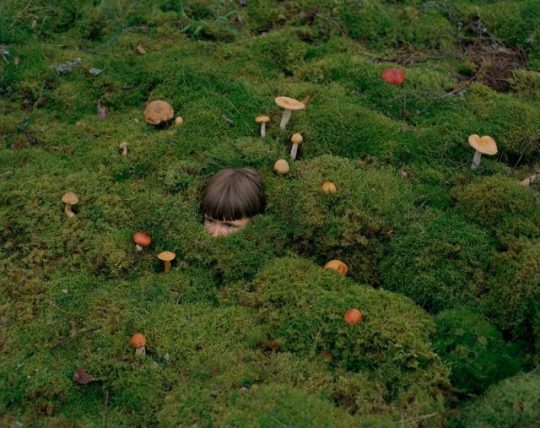
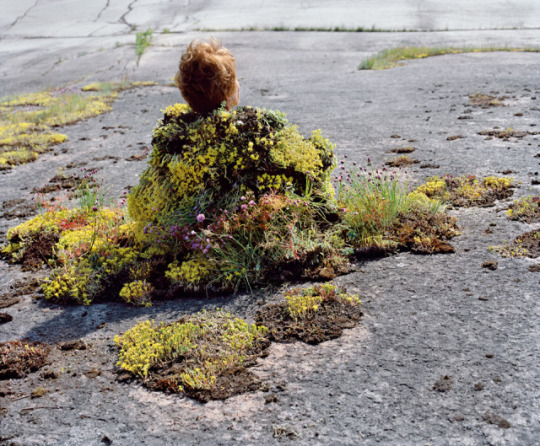
Entwined with Nature: Riita Ikonen's Ethereal Portraits of Human and Environment
#fashion#environmental art#mixed media#portrait#photography#finnish art#contemporary#textile art#riita ikonen
88 notes
·
View notes
Text

Finnish woman, Finland, by Elisa Nelli
#finland#finnish#europe#western europe#folk clothing#traditional clothing#traditional fashion#cultural clothing
188 notes
·
View notes
Photo

Elias, 21
“I’m wearing my beloved thrifted leather jacket with a light brown skirt and jeans. My style is influenced by anticyclones and low pressure areas. It is like they are giving me commands on what to wear. You might think you are the one pulling the strings but in reality your self-determination is in a cage and it is the weather who holds the key to it. A dog would wear a raincoat if it knew any better.”
26 May 2023, Otaniemi
#hel looks#street snap#street style#street style blog#thrifted#outfits#Helsinki Finland#helsinkians#finnish fashion
442 notes
·
View notes
Text

Finnish fashion modeled in Rovaniemi, Finland, 1964. Photographed by Helge Heinonen.
(source: Museovirasto via Europeana Collections)
#vintage fashion#finnish fashion#1960s fashion#finland#rovaniemi#winter fashion#helge heinonen#fashion photography
6 notes
·
View notes
Text
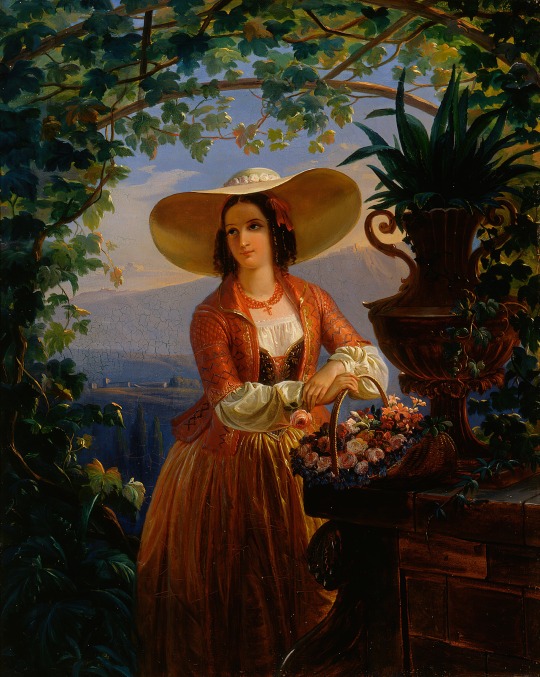
Italian Flower-Girl, 1845 Robert Wilhelm Ekman
#finnish art#romanticism#art#painting#art history#fashion#portrait#nature#flowers#idyllic#Robert Wilhelm Ekman
121 notes
·
View notes
Text


fashion photos of Finnish 1970s model Sirkka Saponen (source: Thomas Hawk / Flickr)
48 notes
·
View notes
Text
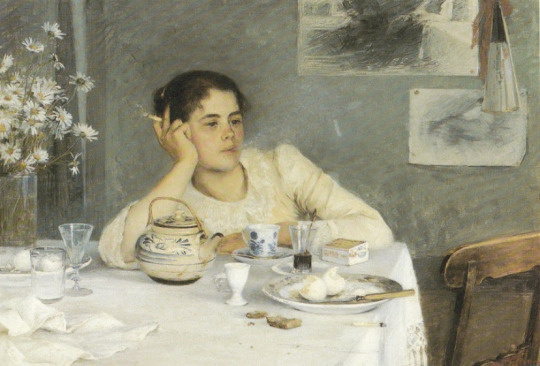
After Breakfast, Elin Danielson-Gambogi. 1890.
#art#art history#aesthetic#victorian aesthetic#victorian#gilded age#1890s#1890s fashion#Finland#Finnish art
160 notes
·
View notes
Text
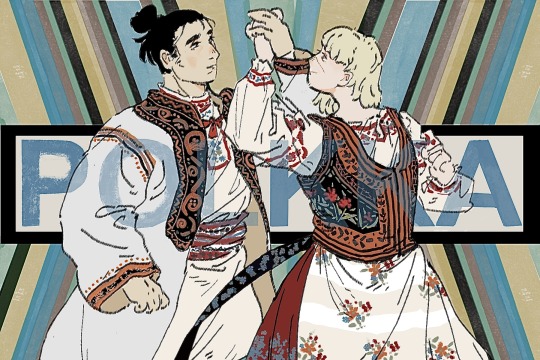
Here is my daily dose of Slavic power and kind of a Valentine's Day special
#chi: about the movement of the earth#chi: on the movements of the earth#orb: on the movements of the earth#okubade#poland#polska#polka#i chose to spell polkka because it looks like polska#tell me polkka is a real word in Finnish right#otherwise this would be super awkward#slavic culture#slavic tradition#slavic folklore#slavic#folk art#folk fashion
40 notes
·
View notes
Text

Tarja 💜💜💜
Promo from the 'Dark Christmas' album.
#music#metal#heavy metal#spotify#tarja#tarja turunen#symphonic metal#soprano#classical#opera#gothic#goth#dark aesthetic#fashion#beauty#beautiful#photography#photoshoot#creepy aesthetic#european#finnish#nightwish#darkness#album#darkchristmas#dark Christmas
31 notes
·
View notes